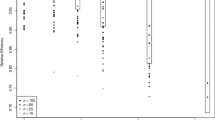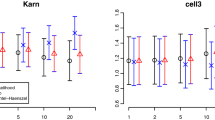Abstract
The semiparametric proportional odds model for survival data is useful when mortality rates of different groups converge over time. However, fitting the model by maximum likelihood proves computationally cumbersome for large datasets because the number of parameters exceeds the number of uncensored observations. We present here an alternative to the standard Newton-Raphson method of maximum likelihood estimation. Our algorithm, an example of a minorization-maximization (MM) algorithm, is guaranteed to converge to the maximum likelihood estimate whenever it exists. For large problems, both the algorithm and its quasi-Newton accelerated counterpart outperform Newton-Raphson by more than two orders of magnitude.
Similar content being viewed by others
References
Becker, M. P., Yang, I. and Lange, K. (1997). EM algorithms without missing data, Statistical Methods in Medical Research, 6, 38–54.
Bennett, S. (1983). Analysis of survival data by the proportional odds model, Statistics in Medicine, 2, 273–277.
Cheng, S. C., Wei, L. J. and Ying, Z. (1995). Analysis of transformation models with censored data, Biometrika, 82, 835–845.
Conn, A. R., Gould, I. M. and Toint, P. L. (1991). Convergence of quasi-Newton matrices generated by the symmetric rank one update, Math. Programming, 50, 177–195.
Cox, D. R. (1972). Regression models and life tables (with discussion), J. Roy. Statist. Soc. Ser. B, 34, 187–220.
Davidon, W. C. (1991). Variable metric methods for minimization, SIAM J. Optim, 1, 1–17.
de Leeuw, J. (1994). Block-relaxation algorithms in statistics, Information Systems and Data Analysis (eds. H. H. Bock, W. Lenski and M. M. Richer), 308–325, Springer, Berlin.
Dempster, A. P., Laird, N. M. and Rubin, D. B. (1977). Maximum likelihood from incomplete data via the EM algorithm, J. Roy. Statist. Soc. Ser. B, 39, 1–38.
Gay, D. M. (1981). Computing optimal locally constrained Steps, SIAM J. Sci. Statist. Comput., 2, 186–197.
Heiser, W. J. (1995). Convergent computation by iterative majorization, Recent Advances in Descriptive Multivariate Analysis (ed. W. J. Krzanowski), 157–189, Oxford University Press, New York.
Hunter, D. R. and Lange, K. (2000). Rejoinder to discussion of optimization transfer using surrogate objective functions, J. Comput. Graph. Statist., 9, 52–59.
Jamshidian, M. and Jennrich, R. I. (1997). Quasi-Newton acceleration of the EM algorithm, J. Roy. Statist. Soc. Ser. B, 59, 569–587.
Khalfan, H. F., Byrd, R. H. and Schnabel, R. B. (1993). A theoretical and experimental study of the symmetric rank one update, SIAM J. Optim., 3, 1–24.
Lange, K. (1995). A gradient algorithm locally equivalent to the EM algorithm, J. Roy. Statist. Soc. Ser. B, 57, 425–437.
Lange, K., Hunter, D. R. and Yang, I. (2000). Optimization transfer algorithms using surrogate objective functions (with discussion), J. Comput. Graph. Statist., 9, 1–59.
Magnus, J. R. and Neudecker, H. (1988). Matrix Differential Calculus with Applications in Statistics and Econometrics, Wiley, New York.
McLachlan, G. J. and Krishnan, T. (1997). The EM Algorithm and Extensions, Wiley, New York.
Murphy, S. A., Rossini, A. J. and Van der Vaart, A. W. (1997). MLE in the proportional odds model, J. Amer. Statist. Assoc., 92, 968–976.
Ortega, J. M. and Rheinboldt, W. C. (1970). Iterative Solution of Nonlinear Equations in Several Variables, Academic Press, Orlando.
Ripley, B. D. (1987). Stochastic Simulation, Wiley, New York.
Seneta, E. (1973). Non-Negative Matrices, Wiley, New York.
Author information
Authors and Affiliations
About this article
Cite this article
Hunter, D.R., Lange, K. Computing Estimates in the Proportional Odds Model. Annals of the Institute of Statistical Mathematics 54, 155–168 (2002). https://doi.org/10.1023/A:1016126007531
Issue Date:
DOI: https://doi.org/10.1023/A:1016126007531




